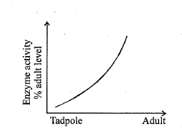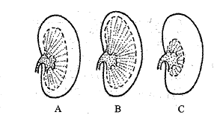How many of the following chordates have flame cells as excretory organ. Planaria, Ascaris, Amphioxus, Tapeworm, Nereis, Scoliodon.

Important Questions on Excretory Products and Their Elimination
Read statements and select the alphabet(s) for which the statement is correct.
| (A) | When some one drinks lot of water, ADH release is decreased. |
| (B) | Exposure to cold temperature suppress ADH release |
| (C) | Caffeine in Tea and coffee increase sodium absorption from DCT and collecting ducts |
| (D) | ADH also cause vasodilation |
Graph depicts the concentration of enzymes involved in urea synthesis in a developing tadpole. It indicates a transition from

The diagrams show vertical sections of kidneys of coypu, brown rate and kangaroo rat, showing the relative size of cortex and medulla. Coypu are found in freshwater and never short of water to drink. Brown rats are able to go some days without drinking at all. Which kidney belongs to which animal?

Identify the correct match from the column I, II and III:
| Column I | Column II | Column III |
| (1) PCT | (a) Podocytes | (i) Small amount of urea enter into it |
| (2) The inner wall of bowman's capsule | (b) Simple squamous epithelium | (ii) Conditional reabsorption |
| (3) Thin ascending segment of loop of Henle | (c) Cuboidal epithelium with less brush border | (iii) Part of filtration membrane |
| (4) DCT | (d) Cuboidal epithelium with more brush border | (iv) Maximum reabsorption of salt and electrolytes |
Which of the following statement is/are true?
I. Glomerular filtrate is isotonic to plasma.
II. When the urine passes into collecting tubule, it becomes hypotonic.
III. Filtrate is isotonic in proximal convoluted tubule.
IV. Filtrate becomes more and more hypotonic as it passes through descending limb of Henle's loop. Choose the correct option
Which of the following features activates the JG cells?
I. Fall in Glomerular blood pressure
II. Fall in Glomerular blood flow
III. Fall in GFR
Choose the correct option
